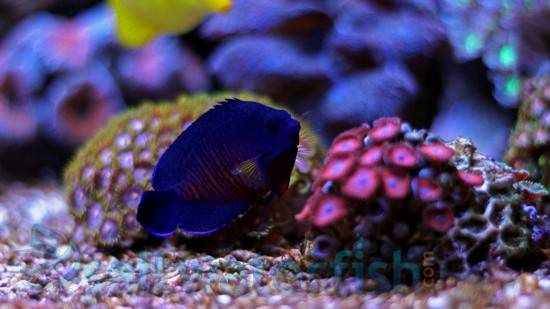Paddlefin Wrasse: Juvenile
Thalassoma lucasanum
(0 Reviews)

Paddlefin Wrasse: Juvenile
Thalassoma lucasanum
(0 Reviews)
{{ item.name }}
Size: {{ item.extra_field_3 }}
${{ getFormattedPrice(item.saleprice) }} ${{ getFormattedPrice(item.price) }}
To join the waiting list, click here
Free Shipping
With
$199.00
or more in Marine Life.
More details...
Paddlefin Wrasse: Juvenile Care Facts
| Care Level: | Moderate |
|---|---|
| Temperament: | Semi-Aggressive |
| Diet: | Carnivore |
| Origin: | Eastern Pacific Ocean |
| Acclimation Time: | 2+ hours |
| Reef Safe: | Monitor |
| Minimum Tank Size: | 60 gallons |
| Max Size: | 6 inches |
The Paddlefin Wrasse (Thalassoma lucasanum), also known as the Cortez Rainbow Wrasse, is common among the waters of the Western United States and Mexico. Males have a vibrant pink or purple body with a yellow-banded neck, and a green or blue head, while females and juveniles have horizontal black and yellow stripes with a lower pink stipe above the belly. They reach a maximum size of 8 inches and should be monitored around crustaceans, as they tend to feed on shrimp and crab. They should be kept with fish of similar temperament, and may be aggressive towards similar species. A lid is recommended, as they are known to jump out of rimless aquariums. Their diet consists of mysis, krill and other invertebrates and they should be fed 2-3 times a day.
Paddlefin Wrasse: A Care Guide for Aquariums
The Paddlefin Wrasse (Thalassoma lucasanum) is a vibrant and captivating species commonly found in saltwater marine environments. This guide provides essential information for enthusiasts interested in keeping this species in their aquariums.
Habitat the Paddlefin Wrasse
Paddlefin Wrasses inhabit coral reefs and rocky areas in the subtropical and tropical waters of the Eastern Pacific Ocean, particularly around the Gulf of California and along the coast of Mexico.
Reef Compatibility of the Paddlefin Wrasse
Generally considered reef-safe, Paddlefin Wrasses may occasionally nip at small invertebrates like ornamental shrimps. However, with ample space and hiding spots, they can peacefully coexist in a reef environment.
Size and Lifespan of the Paddlefin Wrasse
These wrasses can grow up to 8 inches in length. They can live for around 5 to 7 years in captivity with proper care.
Diet in Captivity of the Paddlefin Wrasse
Paddlefin Wrasses are carnivorous and primarily feed on small invertebrates, including crustaceans, worms, and various other small prey. In captivity, they readily accept a diet of high-quality frozen foods like Mysis shrimp, brine shrimp, and finely chopped seafood. Offering a varied diet will ensure their nutritional needs are met.
Aquaculture Availability of the Paddlefin Wrasse
While Paddlefin Wrasses may not be as commonly aquacultured as some other species, they are occasionally available to hobbyists through reputable suppliers.
Compatibility with Other Fish and Invertebrates of the Paddlefin Wrasse
Paddlefin Wrasses can be kept with various fish species, provided they are not overly aggressive or territorial. Compatible tank mates include peaceful species such as Royal Grammas (Gramma loreto), Firefish (Nemateleotris magnifica), Clownfish (Amphiprion spp.), and peaceful dottybacks. Avoid housing them with overly aggressive or predatory species.
Sexual Dimorphism of the Paddlefin Wrasse
Juvenile Paddlefin Wrasses exhibit a distinct color pattern consisting of alternating blue and yellow stripes, while adult males develop a stunning paddle-like extension on their dorsal fin, which gives them their name. Females typically lack this dorsal fin extension and have a less vibrant coloration.
Juvenile to Adult Coloration Changes of the Paddlefin Wrasse
As Paddlefin Wrasses mature, their coloration intensifies, with adult males displaying vibrant blues, yellows, and greens, while females tend to maintain a more subdued appearance.
Temperament of the Paddlefin Wrasse
Paddlefin Wrasses are generally peaceful, but males may exhibit territorial behavior towards other males of the same species. Providing adequate space and hiding spots can help mitigate aggression.
Tank Requirements for the Paddlefin Wrasse
A minimum aquarium size of 75 gallons is recommended for housing a single Paddlefin Wrasse. Larger tanks are preferable if keeping multiples or in a community setup. Rocks and live rock structures should be incorporated to provide hiding places and establish territories. Ensure adequate water flow to mimic their natural habitat.
Water Conditions for the Paddlefin Wrasse
- pH: 8.1-8.4
- Salinity: 1.023-1.025
- Water Temperature: 72-78°F (22-26°C)
- Water Flow: Moderate to high flow is preferred, mimicking the turbulent conditions found in their natural habitat.
Other Common Names for the Paddlefin Wrasse
Paddlefin Wrasses, Cortez Rainbow Wrasses, or Mexican Rainbow Wrasses.
Compatible Tank Mates for the Paddlefin Wrasse
- Royal Gramma (Gramma loreto)
- Firefish Goby (Nemateleotris magnifica)
- Cleaner Wrasse (Labroides dimidiatus)
- Banggai Cardinalfish (Pterapogon kauderni)
- Orchid Dottyback (Pseudochromis fridmani)
Why Purchase from Saltwaterfish.com
Saltwaterfish.com is renowned for its commitment to providing healthy and responsibly sourced marine life. With a focus on sustainability and customer satisfaction, Saltwaterfish.com ensures that all specimens, including Paddlefin Wrasses, are carefully selected and adequately acclimated, allowing enthusiasts to enjoy these captivating creatures confidently.
In conclusion, the Paddlefin Wrasse (Thalassoma lucasanum) is a stunning addition to any saltwater aquarium, offering visual appeal and fascinating behavior. With proper care and consideration of their habitat requirements, these wrasses can thrive in captivity, providing enthusiasts with years of enjoyment.
Reviewed by: Gary Sparks on June 3, 2024
Beautiful fish..I was scared because it was so small but I like watching my fish grow..within 10 min after acclimation this little fish was eating voraciously.big appetite for a Lil fish..i could not be happier I will Def only be ordering exclusively from here
Reviewed by: Lorena Davila on Feb. 18, 2024















